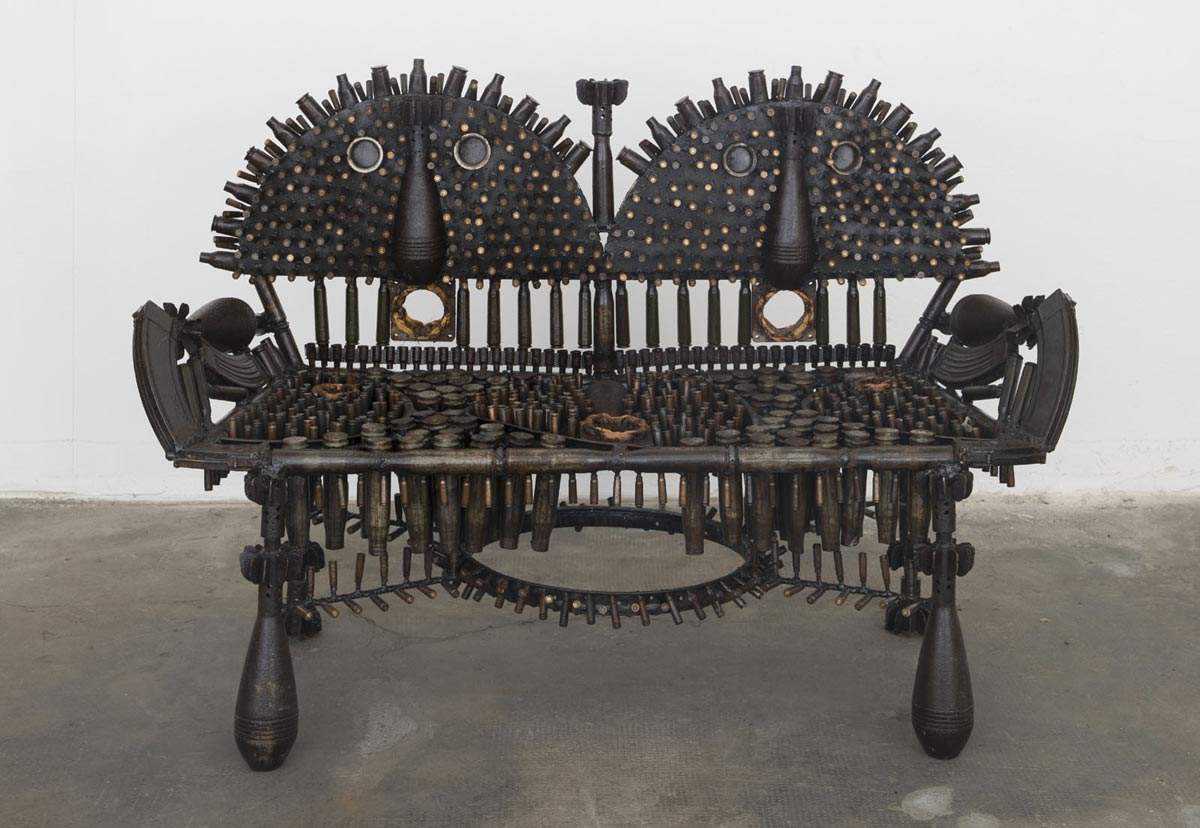It is titled The Hidden Creator and is the solo exhibition featuring Gonçalo Mabunda (Maputo, 1975), an artist originally from Mozambique (a country he is representing at the 2019 edition of the Venice Biennale), from May 19 to June 30, 2019 at Galleria Giovanni Bonelli in Pietrasanta. The exhibition, curated by Alessandro Romanini, displays twenty of the artist’s sculptures created using dismantled war materials such as bullets, parts of rifles and machine guns used in the long and bloody civil war that bloodied his country from 1975 to 1991. Mabunda appropriates war scraps that are disassembled and then reassembled to form masks and thrones with tribal reminiscences characteristic of sub-Saharan culture.
The beginning of his particular production is to be found in the government program called Turning Guns into Hope, in which Mabunda participated as early as 1995. The purpose of the project was to collect the guns still extremely widespread in the territory marked by the just ended civil war, and destroy most of them while the remaining quantity, was handed over to artists, asking them to “transform” them creatively. Mabunda’s masks have the evocative power and retain the symbolic and ritual values of ancient African tribal masks that are part of the culture and tradition with which the artist was born raised. With his creations, Mabunda condemns the atrocities of war and, above all, highlights, in a metaphorical and symbolic key, its inseparable links with the exercise of political power.
The thrones, symbols of the dominion conquered with the weapons of which they are composed, become at the same time denunciations of the vacuity of a government obtained through violence and a short-circuit between technological modernity (of which the weapons are an expression) and the ancestrality of the rituals of the Mozambican people and their collective memory. “Mabunda,” declares curator Alessandro Romanini, “thus presents himself as a creator, in the literal sense of builder, as one who makes visible, through the work of breaking down and recomposing form, a further sense of things. A mediator capable of raising the personal dimension and that of his people to a dimension of universal value. The hidden, evoked in the title refers to the new possibility of existence of objects (the weapons) within an aesthetic structure that in no way mitigates their aggressive impact but channels it into a new possibility of meaning that becomes, by contrast, denunciation and epiphany of a new form of possible life and social relations.”
Gonçalo Mabunda lives and works in Maputo. Despite a childhood spent in a country ravaged by civil war, Mabunda was able to attend schools in Mozambique’s capital, Maputo: he began painting at age 17 and by age 22 began working as a full-time artist. He has to his credit participation in exhibitions in prestigious international institutions such as: the Centre Georges Pompidou in Paris (2005); the Mori Museum in Tokyo (2006); the Guggenheim in Bilbao (2016); Palazzo Reale in Milan (2016); and the Palais de Tokyo in Paris (2018). His first presence at the Venice Biennale was in 2015 while this year, as anticipated, he was selected to represent Mozambique in the national pavilion. Internationally, he collaborates with the Jack Bell Gallery in London. Numerous international awards have been given to him for his commitment as an anti-war activist conveyed through his work.
The exhibition opens Tuesday through Saturday from 10:30 a.m. to 1 p.m. and 3 to 7:30 p.m. Free admission. Catalog in the gallery.
Pictured: Gonçalo Mabunda, Untitled (Throne) (2018-2019; mistra technique). photo Nicola Gnesi
 |
| Art born from weapons used in a bloody civil war. Gonçalo Mabunda's works on display in Pietrasanta, Italy. |
Warning: the translation into English of the original Italian article was created using automatic tools. We undertake to review all articles, but we do not guarantee the total absence of inaccuracies in the translation due to the program. You can find the original by clicking on the ITA button. If you find any mistake,please contact us.